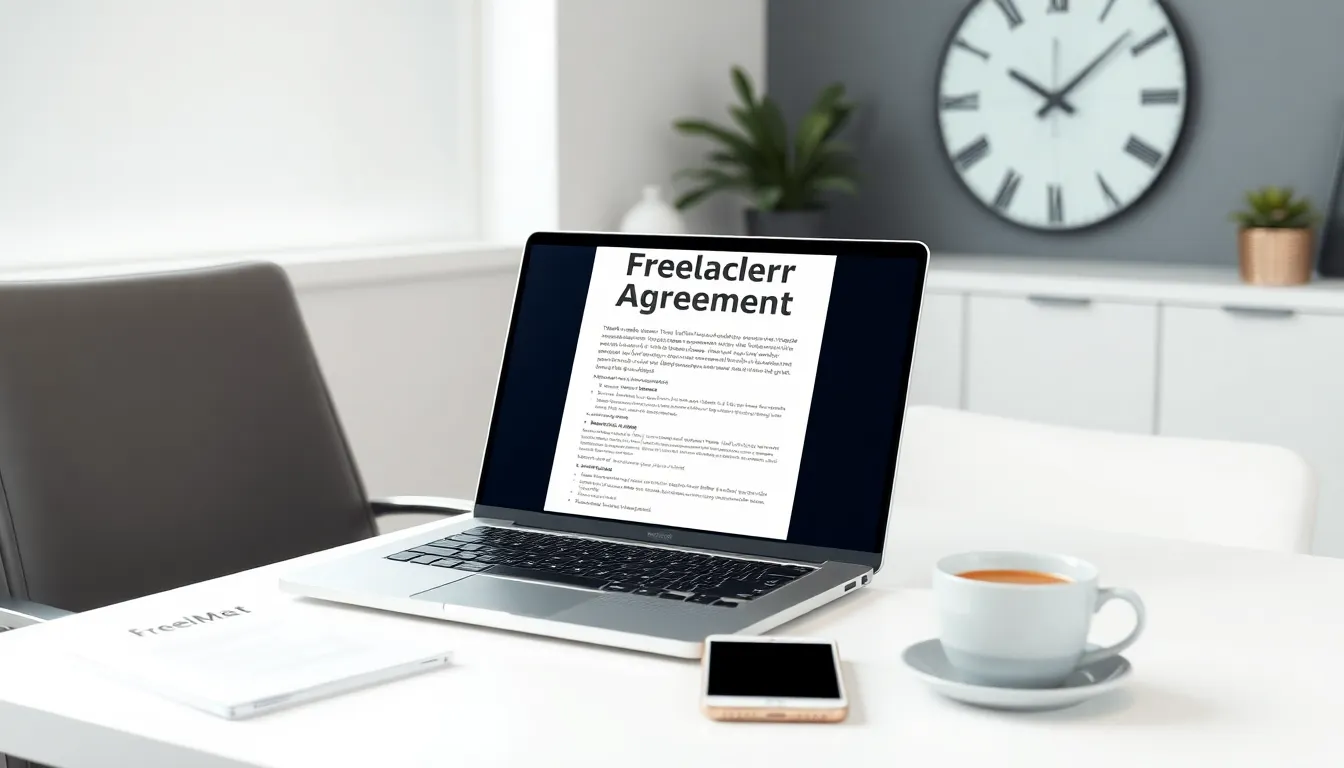Navigating the freelance world can feel like stepping into a bustling bazaar, filled with opportunities, and occasional pitfalls. If you’re a client gearing up to hire talent or a freelancer ready to showcase skills, a freelancer agreement is your trusty map. It serves as the foundation for a smooth working relationship. Whether it’s about payment terms or project scopes, this guide will cover everything you need to craft an ironclad agreement, all while having a good chuckle along the way. Let’s jump into the world of contracts: it’s more exciting than it sounds.
Table of Contents
ToggleUnderstanding Freelancer Agreements

Freelancer agreements are essential documents that clarify expectations between freelancers and their clients. They act like a safety net: without one, that tightrope walk between creative freedom and business liability may feel a tad precarious.
These agreements outline what each party can expect, from project timelines to payment structures. Think of them as the rulebook for a game no one wants to lose. Freelancers often juggle multiple clients, and without a solid agreement, they risk misunderstandings that can sour working relationships. Conversely, clients may be left wondering what they’re paying for without clear guidelines.
In essence, understanding the nuances of these agreements can save everyone involved time, money, and a fair amount of frustration. A well-drafted freelancer agreement isn’t just a document: it’s a mutual handshake that ensures everyone’s on the same page.
Importance of Having a Freelancer Agreement
Having a freelancer agreement is like wearing your favorite pair of shoes: it fits perfectly and keeps you grounded. Without it, chaos can quickly ensue. Here’s why it’s crucial to have one in place.
First, it sets clear expectations on both sides. This clarity fosters a sense of trust, vital for any successful relationship, whether personal or professional. Next, it protects intellectual property rights, reminding both parties who owns what. Typically, the freelancer retains the rights to their work unless specifically transferred to the client.
An agreement also serves as a vehicle for addressing disputes should they arise. If one party feels wronged, having a written record from the outset helps clarify matters and can even avert costly litigation. Eventually, having a freelancer agreement in place acts like a secret weapon, ensuring that everyone understands their roles and responsibilities.
Key Components of a Freelancer Agreement
Crafting a comprehensive freelancer agreement requires attention to detail. Here are the key components that should never be overlooked.
- Scope of Work: Clearly define what is expected of the freelancer, including deliverables and deadlines. A detailed description can avoid confusion and ensure that everyone knows what’s on the table.
- Payment Terms: Specify how and when the freelancer will be compensated. This can include hourly rates, project totals, or milestone payments. Clients appreciate knowing when payments are due, and freelancers benefit from understanding when to expect their checks.
- Revisions and Edits: Outline how many rounds of edits are included in the agreement. This is essential as it protects against endless revisions that could spiral out of control.
- Confidentiality: If freelancers will have access to proprietary information, include a confidentiality clause to safeguard sensitive data. Trust is built on protection, after all.
- Termination Clause: Detail under what circumstances either party can terminate the agreement. This also helps in avoiding any unjustified project exits.
- Ownership of Work: Clarify who will own the finished product. Generally, clients should own the final deliverables unless otherwise agreed upon.
Negotiating Terms in Freelancer Agreements
Negotiation can seem daunting, akin to haggling at a market stall. But, making adjustments to your freelancer agreement is often a vital part of the process. Here are effective strategies for negotiating terms.
Begin with openness. Discuss your expectations clearly, ensuring that both parties voice their needs and concerns. This transparency lays the groundwork for mutual understanding. Next, be flexible. If a client or freelancer requests adjustments, consider alternatives rather than declaring an outright no. A little give-and-take can go a long way.
Hello, compromise. Finding common ground can lead to innovative solutions and creative output. This is particularly beneficial when it comes to payment terms or timelines. Remember, you’re both embarking on a project that requires collaboration, so it’s critical to navigate this with an open mind.
Common Pitfalls to Avoid in Freelancer Agreements
When drafting or signing a freelancer agreement, it’s essential to steer clear of common pitfalls that can lead to future headaches. Here are the top missteps to avoid:
- Vagueness: Failure to clearly define the scope of work can lead to misunderstandings and disputes down the line. Specificity is your friend.
- Ignoring State Laws: Every state has its own set of regulations about freelance work. Familiarizing yourself with these can save you from potential legal trouble later.
- Not Addressing Revision Limits: Allowing unlimited revisions can turn a simple project into a never-ending nightmare. Set clear boundaries to protect both parties.
- Neglecting to Include Payment Terms: Failing to outline payment schedules can lead to confusion and dissatisfaction. Details matter.
- Forgetting to Document Changes: If either party wishes to change the terms later, make sure to document those changes formally. Oral agreements can quickly become muddy.
Tips for Drafting a Comprehensive Freelancer Agreement
Drafting a freelancer agreement doesn’t have to be a challenging job. Here are some handy tips:
- Use Templates: Start with a solid template to save time and ensure you don’t miss anything essential. Many online platforms offer customizable agreements that can serve as a starting point.
- Be Clear and Concise: Avoid legal jargon that can confuse both parties. Use straightforward language that everyone can comprehend.
- Review and Revise: Before finalizing, take the time to review the agreement thoroughly. Make necessary revisions to safeguard both parties’ interests. Consider having a legal professional look it over for added assurance.
- Communicate: Keep lines of communication open while drafting the agreement. Encourage feedback from the other party to ensure that all concerns are addressed.





